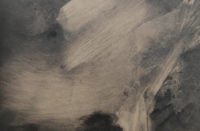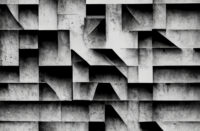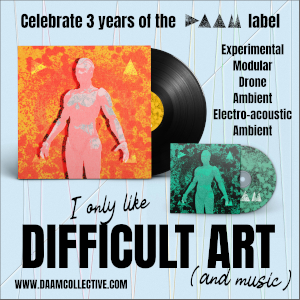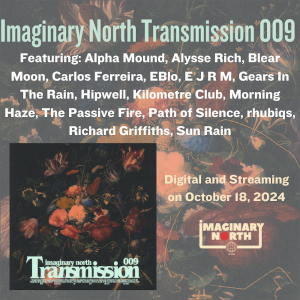
>>> Key
::..:::…..:..::….:::::..:::..:::::::……:::…::.:::….::::..:..:::…::…….::::
 :: Chris Cousin, Michael Manning, Simon Harding and a cast of others invigorate our senses with bright electronica. Poppy chords with multicolored vibes open with Sofalofa’s “Block N Oar” which could be the head-on collision of Boards of Canada with the Soft Pink Truth – its all like a fluffy, puffy laid back lounge sofa. Sinner DC’s “Alice” with its vocodered texts and darker tones make this something you may expect from perhaps the *69 camp, but with feet firmly planted in a slightly more experimental realm, screechy synths and all. Simon Harding’s Yellotone says yo-yo-yo with his triggered dub and crusty sound infringements on the coyly titled “Dubbly More.” 214 (Chris Roman)’s micro-techno “From The Outside” has some strange flares and brittle glitches but remains pretty low key and submissive. Tin-Tole Lata’s “Hue Song” is a funky ditty, swaying under the influence. With the flow of a tape being spun backwards, and toy synths, this is as happy-go-lucky as it gets. “Home to an Empty House” features a bit of the same aesthetic, though, a bit murky, reminding me of a mixed remix of a Depeche Mode instrumental. Subside (Nathan Phillips) has a flare for drama, and probably has repeated many of the tracks from Grace Jones’ “Slave to the Rhythm” one too many times – definitely anchored somewhere in the mid 80s. Michael Manning’s creepy “Overcast” is this set’s stand-out track for dramatic delivery, stuffed with a filling of staccato snaps and bent sequencers. It builds up nicely, and has few enough BPMs that you aren’t feeling totally uncoordinated. Normal (Steve Hyland)’s “Welk” is neither The Normal nor Lawrence Welk – though if you combined them simultaneously backwards and stripped them of vocal and schmaltz you may have a framework for this obtuse track. Cawing crows and creaky wooden drawbridges mute the moment until a flat-funk beat pours through the tunnel. The fairylike drifting headspace of Intonamori’s “Fairly Tall Tales” might not be rated for all audiences but its all about the high. A feather-lite, pert track that sounds too good to be really true, created by Jon Anstee. There is some lighter fare stuck in here for good measure, but most is pretty well sifted into the final recipe.
:: Chris Cousin, Michael Manning, Simon Harding and a cast of others invigorate our senses with bright electronica. Poppy chords with multicolored vibes open with Sofalofa’s “Block N Oar” which could be the head-on collision of Boards of Canada with the Soft Pink Truth – its all like a fluffy, puffy laid back lounge sofa. Sinner DC’s “Alice” with its vocodered texts and darker tones make this something you may expect from perhaps the *69 camp, but with feet firmly planted in a slightly more experimental realm, screechy synths and all. Simon Harding’s Yellotone says yo-yo-yo with his triggered dub and crusty sound infringements on the coyly titled “Dubbly More.” 214 (Chris Roman)’s micro-techno “From The Outside” has some strange flares and brittle glitches but remains pretty low key and submissive. Tin-Tole Lata’s “Hue Song” is a funky ditty, swaying under the influence. With the flow of a tape being spun backwards, and toy synths, this is as happy-go-lucky as it gets. “Home to an Empty House” features a bit of the same aesthetic, though, a bit murky, reminding me of a mixed remix of a Depeche Mode instrumental. Subside (Nathan Phillips) has a flare for drama, and probably has repeated many of the tracks from Grace Jones’ “Slave to the Rhythm” one too many times – definitely anchored somewhere in the mid 80s. Michael Manning’s creepy “Overcast” is this set’s stand-out track for dramatic delivery, stuffed with a filling of staccato snaps and bent sequencers. It builds up nicely, and has few enough BPMs that you aren’t feeling totally uncoordinated. Normal (Steve Hyland)’s “Welk” is neither The Normal nor Lawrence Welk – though if you combined them simultaneously backwards and stripped them of vocal and schmaltz you may have a framework for this obtuse track. Cawing crows and creaky wooden drawbridges mute the moment until a flat-funk beat pours through the tunnel. The fairylike drifting headspace of Intonamori’s “Fairly Tall Tales” might not be rated for all audiences but its all about the high. A feather-lite, pert track that sounds too good to be really true, created by Jon Anstee. There is some lighter fare stuck in here for good measure, but most is pretty well sifted into the final recipe.
::..:::…..:..::….:::::..:::..:::::::……:::…::.:::….::::..:..:::…::…….::::
 :: By taking works from Swedish trio Tape’s (Andreas Berthling, Johan
:: By taking works from Swedish trio Tape’s (Andreas Berthling, Johan
Berthling, and Tomas Hallonsten) first recording, the electro-folk “Opera” ten artists have made related works that build on patterns of the originals. David Grubbs melancholic “Radio Baroque” elongates strings and mysterious concave verandas. Tomlabs’ Japanese duo Fonica (Keiich Sugimoto and Cheason) make “crossing longitude” like a breezy flight on the expired Concorde. The light phrasing and restrained rewind play keeps the rough organic nature of Tape’s original intact but adds a seamless glow of ambiguity. BJ Nilsen as Hazard adds some pretty stunted microbeats to his climbing “Noises from a Hill.” Unyielding, though a slight bit boring until it starts to fall apart in its final minute where the craggy edges meet the beats head on and the match just starts, but at only 4 and a half minutes a bit too late in the mix, however. Entering from the Netherlands is Rechord (Andreas Tilliander) who patterns its theme song perhaps on the match-up “taperechorder.” This is just plain upright and over – with a slight archival quality of an old jazz record through an 8-track splicer. Juicy stuff.
The recently prolific sightings of Oren Ambarchi doesn’t at all effect his brilliant reworking of “Summa Afrique” – in fact this in many ways has what I felt the original lacked, a fluffy, but determined dreamlike quality. It is as if he took their rendition out into the rain and exorcized it from its weather beaten limp frame, cleaned, powdered and dressed it all up for a hovering night on the town. “HBR 64507 mix” is Pita’s deconstruction. This gives Peter Rehberg the opportunity to hone in on the finer nuances of his often-caustic edge; Surprisingly ambient with a flare or two, and lots of crisp glitch. Japanese electro-acoustic quartet Minamo (apestaartje, 360 Records) delivers an existential chamber drone on “perse.” With a limited flow of quiet harmony they incorporate curves in tonal frequencies with intermittent muffled wind-up gadgets that are glossed over with a breath of air. “Perfume” drifts, perches, and pulsates throughout my head, triggering my senses to imagine that Town & Country’s Josh Abrams (Thrill Jockey, Lucky Kitchen) keeps developing his craft in astonishing ways. There is a dissonant message of turmoil in this idiomatic essence filling the air – a virally potent. (Brendon) Anderegg makes “Bee Song” sound like a toy lullaby. Its semi-sweet sing-song harmony is a welcome treat, with a lighter-than-airiness style – pure, smooth, curvaceous. “a bell made of bones” is the final cut on a close to superb collection. Here, multidimensional sound artist Stephan Mathieu (Fallt, Orthlong, etc.) designs the space inside and out of Tape’s original “Bell Mountain” where it just floats by and away. The track becomes a languid fairyland spun deftly through a floral field – an illusion of puffy building clouds, and early warning signs of Spring.
Surely the task for these artists was a challenge to take the originals apart from their many surprising spatial pockets and resonant sphere. Almost everyone here truly zoomed in on the ultra-fine sensibilities of the trio’s deranged folk intent.
::..:::…..:..::….:::::..:::..:::::::……:::…::.:::….::::..:..:::…::…….::::
 :: This modern evolving electronic ensemble is a large cast of over 25 characters including Richard Francis, Rosy Parlane, Tetuzi Akiyama, Jonathan Coleclough, John Weise, Ralf Wehowsky and Reynols among many other talented musicians and composers. This is veritable acoustics vs. electronics big band. Over ten blended, untitled tracks, the blatant minimalism baffles with such a cast of sound aestheticians in the house. I’m not quite sure how they put all this together but can attest that the outcome is formally plotted, well balanced and sparsely furnished. From warped clanging metals and shovels hitting cement to deeply enforced drones and open-air field recordings, this is a truly experimental listen. Besides for candid moments found in selected Crawl Unit material and some of what Stilluppsteypa is doing, there isn’t much else to compare this jangly jamboree to. You may think that when a mass exodus of people wielding instruments such as boiling water, broken amps, diseased CDRs, fire, baby monitors and a whole stack of acoustic strings and thing, not to mention all the electronic gizmos you could fit in an amphitheatre, that it could be an immense chaos of the sound stratosphere. This is absolutely not the case on With Maples Ablaze – quite contrary, the atmosphere is quite calming, with a harmonious drone, and the combo of organic sound meets industry at every turn. From spaceflight to crash and burn, this is one of those recordings that is so purely rooted in its layers of weightless atmosphere you may have a hard time imagining your own personal space – so it is recommended to play this in a comfy nook with low light. There are crackling recordings of rough wooded brush, metal on metal and the capture of incidental daily sounds that make you feel like you are right there in the moment. As a subway train passes by, rivets are soldered, and certain sounds of industry produce double meanings. Then there giddy outsider sounds of what could be bluegrass spun backwards, resulting in something that could be described as Bulgarian chipmunks playing gamelan. The percussion is intermittently something resembling a marching band warm-up routine to that of a reverie call. Streaming waters mix with bowed guitar interpreting a form of salvation in the midst of implied malevolence. It is pretty impossible to isolate what artist is playing where on this disc, but this isn’t USA for Africa or even Alexander’s Ragtime Band! No, Birchville Cat Motel is a physical ensemble that uses its passionate interconnectedness to ring out cold case untold truths with a proclivity for virtual trance.
:: This modern evolving electronic ensemble is a large cast of over 25 characters including Richard Francis, Rosy Parlane, Tetuzi Akiyama, Jonathan Coleclough, John Weise, Ralf Wehowsky and Reynols among many other talented musicians and composers. This is veritable acoustics vs. electronics big band. Over ten blended, untitled tracks, the blatant minimalism baffles with such a cast of sound aestheticians in the house. I’m not quite sure how they put all this together but can attest that the outcome is formally plotted, well balanced and sparsely furnished. From warped clanging metals and shovels hitting cement to deeply enforced drones and open-air field recordings, this is a truly experimental listen. Besides for candid moments found in selected Crawl Unit material and some of what Stilluppsteypa is doing, there isn’t much else to compare this jangly jamboree to. You may think that when a mass exodus of people wielding instruments such as boiling water, broken amps, diseased CDRs, fire, baby monitors and a whole stack of acoustic strings and thing, not to mention all the electronic gizmos you could fit in an amphitheatre, that it could be an immense chaos of the sound stratosphere. This is absolutely not the case on With Maples Ablaze – quite contrary, the atmosphere is quite calming, with a harmonious drone, and the combo of organic sound meets industry at every turn. From spaceflight to crash and burn, this is one of those recordings that is so purely rooted in its layers of weightless atmosphere you may have a hard time imagining your own personal space – so it is recommended to play this in a comfy nook with low light. There are crackling recordings of rough wooded brush, metal on metal and the capture of incidental daily sounds that make you feel like you are right there in the moment. As a subway train passes by, rivets are soldered, and certain sounds of industry produce double meanings. Then there giddy outsider sounds of what could be bluegrass spun backwards, resulting in something that could be described as Bulgarian chipmunks playing gamelan. The percussion is intermittently something resembling a marching band warm-up routine to that of a reverie call. Streaming waters mix with bowed guitar interpreting a form of salvation in the midst of implied malevolence. It is pretty impossible to isolate what artist is playing where on this disc, but this isn’t USA for Africa or even Alexander’s Ragtime Band! No, Birchville Cat Motel is a physical ensemble that uses its passionate interconnectedness to ring out cold case untold truths with a proclivity for virtual trance.
With Maples Ablaze gets a huge nod for its superb production, editing, conducting as it is obvious that the artists involved truly worked together in a mystical way to complement each other rather than stand out like soloists – Birchville Cat Motel is a real amalgamation of co-op sound power!
::..:::…..:..::….:::::..:::..:::::::……:::…::.:::….::::..:..:::…::…….::::
 :: Coming immediately alive with the wobbly technotronic “Furry Bicycle” by Duplo_Remote, the newest Split Series is underway. DAT Politics returns to form with Et Hop, where the head on literal collision of clicks/cuts meets funky hip-hop scratchin’ (circa early 80s). The “vs.” effect tries old school on for size in a leaner electronic body. There seems like a lot of extra hot air for some reason. Christoph De Babalon takes on a jungle theme in the totally discardable porno themed “Cum On (Feel This)” – not a highlight here. It’s been done a million times before and frankly; we’re bored (and YES I mean the “royal” we). And then Com.A’s “Raider” tries out for the same referential styling but makes the attempt to contemporize the sound by using a variable pitch to tone scale and it could be 300BPMs for all I know – it sounds fast and furious! “Flutter” is Kid606’s contribution – and for what it’s worth – beyond his saturation in the field – this is yet, another brilliant example of his talent for splicing key vocal adlibs and branding them with style. Process, one of my favorite acts of the last 4 years or so has a typically standout track with “Popbeat” – a sort of hip tap-dance with a funky percussive heart. The woody beat is right up front and crystal clear amid a wavering and stunted orchestral styled background.
:: Coming immediately alive with the wobbly technotronic “Furry Bicycle” by Duplo_Remote, the newest Split Series is underway. DAT Politics returns to form with Et Hop, where the head on literal collision of clicks/cuts meets funky hip-hop scratchin’ (circa early 80s). The “vs.” effect tries old school on for size in a leaner electronic body. There seems like a lot of extra hot air for some reason. Christoph De Babalon takes on a jungle theme in the totally discardable porno themed “Cum On (Feel This)” – not a highlight here. It’s been done a million times before and frankly; we’re bored (and YES I mean the “royal” we). And then Com.A’s “Raider” tries out for the same referential styling but makes the attempt to contemporize the sound by using a variable pitch to tone scale and it could be 300BPMs for all I know – it sounds fast and furious! “Flutter” is Kid606’s contribution – and for what it’s worth – beyond his saturation in the field – this is yet, another brilliant example of his talent for splicing key vocal adlibs and branding them with style. Process, one of my favorite acts of the last 4 years or so has a typically standout track with “Popbeat” – a sort of hip tap-dance with a funky percussive heart. The woody beat is right up front and crystal clear amid a wavering and stunted orchestral styled background.
This 17-track collection also includes the mentionable additions by Fennesz, Ultra Red, David Grubbs and others. Main’s signature drone becomes a nuclear speedway on ice. There actually seems to be two separate tracks going at once – one inaudibly high-speed and one just levitating. It’s a smoke screen for sure. Avey Tare’s “Crumbling Land” is like a batch of grade school kids grabbing a Ronco Record player and doing ill justice to St. Peppers Lonely Hearts Club Band – singing something about a werewolf – its weird, believe me. A surprise addition here is Matmos’ totally micronized digital disco (ala Daft Punk) on their lil’ ditty called “Freak N’ You.” Taking some soul record and just cutting a rug in half. They must have won the lottery – it’s THAT up! Oh my, I can’t stop talking about this record because Ultra Red has offered their syncopated “A16 (edit)” and unlike the regular political hyjinx, this one has all the cadence of a street-based Double Dutch hopscotch, and a beat-bustin’ chant repeating “We Say No!” or “We Say Now!” – or something like that. QT?s “qqq” is forty-eight second trip through Willy Wonka’s factory tunnel, only backwards and blindfolded while coved in a bath of sticky marshmallow. And Lucky Kitchen’s Alejandra & Aeron’s aptly titled “Kitchen (edit)” is like a musical fairy box that exploded glitter vastly over a city on fire, the flames grow higher and more colorful and the city ends up covered in a molten layer of metallic. To conclude a Catalonian woman sings lovingly as the sizzling kitchen perfects the melding of all its ingredients. I only can say I want the extended version rather than the edit, or at least the recipe. It’s one of the most danceable things I have ever heard them indulge in.
The fat cat is bustin’ out.
::..:::…..:..::….:::::..:::..:::::::……:::…::.:::….::::..:..:::…::…….::::
 :: Six and More is just that, an ensemble of about 40 sound makers playing double that instrumentation from radio and scanner to groove box and cello and just about everything that makes noise under the sun. This live recording contains no overdubs, and is instantly startling because what could be a big chaos orchestral mish-mash turns out to be quite a theatrical design that sounds sparsely composed. From pictures it appears that the musicians sat around a big rectangular table arrangement in a concrete and brick warehouse somewhere off one of Rotterdam’s less beaten country roads, in Munich and elsewhere. The players are in full harmony, pacing percussion and electronics, voices and strings in observant overtures that gain from the dissonant resident space on “Abflug aus der Fahrradwerkstatt.” Deep synths mirror the belly of the contrabass while others tweak knobs and tease with unsympathetic feedback frequencies. To counter the plasticity, the organic crunchy grooves from vinyl become somewhat romantic in the same way old family films fade in and out of memory. “Way Out” could infer the flavors of “out” jazz, but its atonality makes labels virtually invisible on this one, its pure experimental on all ends. I hear chirping birds, horse hooves hitting gravel, but I know its just a mirage, a mélange of many obscure sounds collaged in a way that fools the way the ear perceives sound – requiring several listens to catch something new each time. So is it a puzzle or just a subliminal ploy? As “Vegetative Elemente unter Tage” unveils itself, probably a little bit of each. But just as sweaty as you get from a good long mountain hike, this is a truly physical recording that has a similar angle (pun intended). There are fleeting moments when Six and More play with the vestiges of contemporary electronica as witnessed on the zim-zoom radio waves and crackling wooden percussion on “Wir covern auf keinen Fall Australien” – but this seems quite beside their point. Not that the “point” is matter of fact – it’s more a purposeful, illusive approach to the genre.
:: Six and More is just that, an ensemble of about 40 sound makers playing double that instrumentation from radio and scanner to groove box and cello and just about everything that makes noise under the sun. This live recording contains no overdubs, and is instantly startling because what could be a big chaos orchestral mish-mash turns out to be quite a theatrical design that sounds sparsely composed. From pictures it appears that the musicians sat around a big rectangular table arrangement in a concrete and brick warehouse somewhere off one of Rotterdam’s less beaten country roads, in Munich and elsewhere. The players are in full harmony, pacing percussion and electronics, voices and strings in observant overtures that gain from the dissonant resident space on “Abflug aus der Fahrradwerkstatt.” Deep synths mirror the belly of the contrabass while others tweak knobs and tease with unsympathetic feedback frequencies. To counter the plasticity, the organic crunchy grooves from vinyl become somewhat romantic in the same way old family films fade in and out of memory. “Way Out” could infer the flavors of “out” jazz, but its atonality makes labels virtually invisible on this one, its pure experimental on all ends. I hear chirping birds, horse hooves hitting gravel, but I know its just a mirage, a mélange of many obscure sounds collaged in a way that fools the way the ear perceives sound – requiring several listens to catch something new each time. So is it a puzzle or just a subliminal ploy? As “Vegetative Elemente unter Tage” unveils itself, probably a little bit of each. But just as sweaty as you get from a good long mountain hike, this is a truly physical recording that has a similar angle (pun intended). There are fleeting moments when Six and More play with the vestiges of contemporary electronica as witnessed on the zim-zoom radio waves and crackling wooden percussion on “Wir covern auf keinen Fall Australien” – but this seems quite beside their point. Not that the “point” is matter of fact – it’s more a purposeful, illusive approach to the genre.
Way Out displays the possibilities of what it would be like if Marcel Duchamp had a marching (err sitting) band. With the cautionary flaws included, this big band made it to this final stage in four concerts, excerpted here. Towards the end they invert the possibilities of just warming up, like a symphony orchestra in a big concert hall, the beginning of the end!
::..:::…..:..::….:::::..:::..:::::::……:::…::.:::….::::..:..:::…::…….::::
 :: St. Gallen Switzerland’s Voice Crack (Andy Guhl and Norbert Möslang) have been playing with sound together dating back to the 70s, dedicated to exclusive broken up and down electronics since the early 80s. For this new compilation of remixes they instantly take on take on the ever sprite and whacky Hrvatski (Keith Fullerton Whitman). On “Cracked Everyday Electronics Home Repair Course” at first there is no real distinction between this or Squarepusher. Upon the prelude’s completion where an ill-ease full-on warped distortion of droned blurry guitars and birdie type calls takes center spotlight; Silence is infested by teeny static invaders on Jim O’Rourke’s nearly incandescent, “Mandatory Plastic Cup.” The hide-n-seek, pop-up beats of Aphasic’s “Hyperion” show the rockier side of all that be deemed “clicks n’ cuts.” Matmos’ turn on the twisted “Rainbow Sound File for Voice Crack” is a caffeine shot to the ear, meandering from left to right, fast-paced and brimming with a batch of their unusual hybrid of bouncing, bleeped soundscape. Bleeding right into the mix is Möslang‘s own rebuild of his “Without Blue Mix”. In six minutes the machine gun staccatto vs. ambient bass lines shifts frequently like an anxious feline. At over seven minutes (Russell) Haswell & (Florian) Hecker draw the blinds on the outside world to predispose themselves to raw noise carnage. On the titled challenged “Orange-Time-Shock-Formant-Wave-Re-Composition” it’s as though they’ve taken the whole digital means straight to turntablist antics. The glitch is totally freaked out and by all accounts a raucous meant to be force fed Clockwork Orange style. I think it lopped away a portion of my eardrum. The “Final [k]” here is a treated percussion track by Toby Reynolds aka DJ Skud (and Ambush head honcho), saving the uncertain best for last. This pure frequency-based anomaly is a straight-ahead jitterthon. Its ripe noise has gothica written all over it – sonic elements that make other acts like Mlhest and Wolf Eyes so promising.
:: St. Gallen Switzerland’s Voice Crack (Andy Guhl and Norbert Möslang) have been playing with sound together dating back to the 70s, dedicated to exclusive broken up and down electronics since the early 80s. For this new compilation of remixes they instantly take on take on the ever sprite and whacky Hrvatski (Keith Fullerton Whitman). On “Cracked Everyday Electronics Home Repair Course” at first there is no real distinction between this or Squarepusher. Upon the prelude’s completion where an ill-ease full-on warped distortion of droned blurry guitars and birdie type calls takes center spotlight; Silence is infested by teeny static invaders on Jim O’Rourke’s nearly incandescent, “Mandatory Plastic Cup.” The hide-n-seek, pop-up beats of Aphasic’s “Hyperion” show the rockier side of all that be deemed “clicks n’ cuts.” Matmos’ turn on the twisted “Rainbow Sound File for Voice Crack” is a caffeine shot to the ear, meandering from left to right, fast-paced and brimming with a batch of their unusual hybrid of bouncing, bleeped soundscape. Bleeding right into the mix is Möslang‘s own rebuild of his “Without Blue Mix”. In six minutes the machine gun staccatto vs. ambient bass lines shifts frequently like an anxious feline. At over seven minutes (Russell) Haswell & (Florian) Hecker draw the blinds on the outside world to predispose themselves to raw noise carnage. On the titled challenged “Orange-Time-Shock-Formant-Wave-Re-Composition” it’s as though they’ve taken the whole digital means straight to turntablist antics. The glitch is totally freaked out and by all accounts a raucous meant to be force fed Clockwork Orange style. I think it lopped away a portion of my eardrum. The “Final [k]” here is a treated percussion track by Toby Reynolds aka DJ Skud (and Ambush head honcho), saving the uncertain best for last. This pure frequency-based anomaly is a straight-ahead jitterthon. Its ripe noise has gothica written all over it – sonic elements that make other acts like Mlhest and Wolf Eyes so promising.
In all, these seven tracks blend to make a quirky collection that will drain your bad pop toxins for days.
::..:::…..:..::….:::::..:::..:::::::……:::…::.:::….::::..:..:::…::…….::::
 :: Compiled by Joe Abrescia in 2001, Colliding Frequencies has been on the back burner until now, so is it worth its wait? To start things off Moonsanto’s “Our Statistics: Sixty Percent” has been aptly mixed by Starlink to create a burp/buzz sine tone meets Cabaret Voltaire minimalist overture. The lashing out of Converter’s “EHS” is a bit more standard fare sounding like they’ve taken the Chemical Brothers by the hair and just pulled too hard; It’s acid-washed sandpaper to the vinyl of the aforementioned. “Blind, Deaf and Mute” is a recycled jungle blitz by Manufactura. Hmmm, why does the Pet Shop Boys’ “Being Boring” instantly come to mind upon the first listen to Exclipsect’s “Aparture”? The track then becomes a caustic degradation on its initial intriguing tones. The tiny tapping of Tarmvred’s “Insekter” with its impending, inhalated layer of dark doom, and eyebrow curling drama stays insular without ever truly imploding. This technique actually builds intrigue, and when the percussive overlayer kicks in its done like an elegantly collapsed house of cards, playing with your aural channeling. This 18-track comp has a multitude of new names and an edge of minimal post-gothic polarities, some filler and rehashing of the lessons taught by their forefathers from the house of Wax Trax. But among them are interesting new takes on these forgotten elegies such as the riveting percussion of Idyl’s “Being Human” and a very welcome appearance by Klangstabil who’s “Dash” is the condensation of static electricity and flippant raw percussion. The whip-crack industrial buzz is slightly funkier than you’d expect from this invisible band, but proves that there is life after a few classic records on Ant-Zen and Hymen. Radial’s “Reflections” is one of the standout tracks on this collection, comprised of two forged layers of machine crunch and floating synth drone that is whistle-like even as shots ring out repeatedly to a tenuous beat. This type of work takes apart atonalism to create a flow that is choppy yet makes some uncertain sense. An appearance by Ultra Milkmaids has the subtlety of the spin of an auto ignition, muted and pulsing atop a playful oompa loop song played side-wards. The ‘maids play hide-n-seek with the multiple layers of acoustic data crunching. “Play – So Sorry” is by far the most profound work here and hangs like a Picasso from the batch, making it only awkwardly belong here, but based on the collection’s title this live piece is the dose of distraction you are illing for. Following on these heels comes the fiery boil of Q-Drik’s “La Compotte Crapotte” which sounds like a super-amplification of some of the darker nights on the desert playa of Burning Man.
:: Compiled by Joe Abrescia in 2001, Colliding Frequencies has been on the back burner until now, so is it worth its wait? To start things off Moonsanto’s “Our Statistics: Sixty Percent” has been aptly mixed by Starlink to create a burp/buzz sine tone meets Cabaret Voltaire minimalist overture. The lashing out of Converter’s “EHS” is a bit more standard fare sounding like they’ve taken the Chemical Brothers by the hair and just pulled too hard; It’s acid-washed sandpaper to the vinyl of the aforementioned. “Blind, Deaf and Mute” is a recycled jungle blitz by Manufactura. Hmmm, why does the Pet Shop Boys’ “Being Boring” instantly come to mind upon the first listen to Exclipsect’s “Aparture”? The track then becomes a caustic degradation on its initial intriguing tones. The tiny tapping of Tarmvred’s “Insekter” with its impending, inhalated layer of dark doom, and eyebrow curling drama stays insular without ever truly imploding. This technique actually builds intrigue, and when the percussive overlayer kicks in its done like an elegantly collapsed house of cards, playing with your aural channeling. This 18-track comp has a multitude of new names and an edge of minimal post-gothic polarities, some filler and rehashing of the lessons taught by their forefathers from the house of Wax Trax. But among them are interesting new takes on these forgotten elegies such as the riveting percussion of Idyl’s “Being Human” and a very welcome appearance by Klangstabil who’s “Dash” is the condensation of static electricity and flippant raw percussion. The whip-crack industrial buzz is slightly funkier than you’d expect from this invisible band, but proves that there is life after a few classic records on Ant-Zen and Hymen. Radial’s “Reflections” is one of the standout tracks on this collection, comprised of two forged layers of machine crunch and floating synth drone that is whistle-like even as shots ring out repeatedly to a tenuous beat. This type of work takes apart atonalism to create a flow that is choppy yet makes some uncertain sense. An appearance by Ultra Milkmaids has the subtlety of the spin of an auto ignition, muted and pulsing atop a playful oompa loop song played side-wards. The ‘maids play hide-n-seek with the multiple layers of acoustic data crunching. “Play – So Sorry” is by far the most profound work here and hangs like a Picasso from the batch, making it only awkwardly belong here, but based on the collection’s title this live piece is the dose of distraction you are illing for. Following on these heels comes the fiery boil of Q-Drik’s “La Compotte Crapotte” which sounds like a super-amplification of some of the darker nights on the desert playa of Burning Man.
To conclude, Red Reflection takes to the piano to sooth the chasms created along the edges of “Colliding Frequencies” with a dusting of faded glory for good measure. The sequencers are those made for film soundtracks and its orchestral emphasis is higher than thou. The ending is certainly out of place, but there was no township fully erected on this fragmented mix of durable ingredients in the first place. It will probably go down as well as a swig of wheat grass guts, and glory.
::..:::…..:..::….:::::..:::..:::::::……:::…::.:::….::::..:..:::…::…….::::
 :: OK, you now know nothing is “sacred” when it comes to remixing and recontextualizing a genre. From Gregorian Chant to Dub, some of the worlds most unexpected sounds have come from the fusion of electronic reinterpretations of world music, and this collection is no different. Electric Gypsyland has a range of international artists from a variety of synthetic to jazz-acoustic circles taking on the often celebratory sound-making of gypsies. By collapsing any impression of what this might be about you will be in for a wild ride, as most actually sticks to the original scope of the hilarity and joyous nature warranted by communities in constant flight, without a home base. Though the wonderfully creative imagination of Senor Coconut may have seen their last live performance, and what a performance it was, at last year’s Mutek, they contribute to the Kocani Orkestar’s instrumental “Usti, Usti Baba” with barking pups and all – though minus their signature narration. The uplifting beat of this full-bodied music is all mixed overlapping right into DJ Dolores’ “Dumbala Dumba” as she vs. Taraf de Haidouks and repeated from track to track throughout. And so it goes, with the bellowing vocals on Juryman’s take on “Cind Eram la ’48” there is an air of rapid percussion, happy horns and accordion right into Gaetano Fabri’s “Siki, Siki Baba.” The atmosphere is up and lively, warm as the sun of the equator and silly as a minstrel show. It is a certain circus mentality, with bellowing, large scale vocals here and there. Bigga Bush vs. Kocani Orkestar sounds like a deep dub “Slave to the Rhythm” era Grace Jones. Modern Quartet take on “Fantasia for Clarinet” and bring electronic beats to the flouncy, charming clarinet into a mix of myriad flavors and tonalities. “Mugar Mugurel” is rescripted by Arto Lindsay and Melvin Gibbs to a bundle of vibrating clap tracks and open/close punctuated beats. And just when you had your hips in a tizzy comes an additional two bonus tracks that break open the doors to the house. Cop & Thief’s “A La Turk” mix that sounds like something that might come from the folks at the Moonshine imprint.
:: OK, you now know nothing is “sacred” when it comes to remixing and recontextualizing a genre. From Gregorian Chant to Dub, some of the worlds most unexpected sounds have come from the fusion of electronic reinterpretations of world music, and this collection is no different. Electric Gypsyland has a range of international artists from a variety of synthetic to jazz-acoustic circles taking on the often celebratory sound-making of gypsies. By collapsing any impression of what this might be about you will be in for a wild ride, as most actually sticks to the original scope of the hilarity and joyous nature warranted by communities in constant flight, without a home base. Though the wonderfully creative imagination of Senor Coconut may have seen their last live performance, and what a performance it was, at last year’s Mutek, they contribute to the Kocani Orkestar’s instrumental “Usti, Usti Baba” with barking pups and all – though minus their signature narration. The uplifting beat of this full-bodied music is all mixed overlapping right into DJ Dolores’ “Dumbala Dumba” as she vs. Taraf de Haidouks and repeated from track to track throughout. And so it goes, with the bellowing vocals on Juryman’s take on “Cind Eram la ’48” there is an air of rapid percussion, happy horns and accordion right into Gaetano Fabri’s “Siki, Siki Baba.” The atmosphere is up and lively, warm as the sun of the equator and silly as a minstrel show. It is a certain circus mentality, with bellowing, large scale vocals here and there. Bigga Bush vs. Kocani Orkestar sounds like a deep dub “Slave to the Rhythm” era Grace Jones. Modern Quartet take on “Fantasia for Clarinet” and bring electronic beats to the flouncy, charming clarinet into a mix of myriad flavors and tonalities. “Mugar Mugurel” is rescripted by Arto Lindsay and Melvin Gibbs to a bundle of vibrating clap tracks and open/close punctuated beats. And just when you had your hips in a tizzy comes an additional two bonus tracks that break open the doors to the house. Cop & Thief’s “A La Turk” mix that sounds like something that might come from the folks at the Moonshine imprint.
So, throw on some golden medallions and dance the night away, leave your own tradition behind and lose it!
::..:::…..:..::….:::::..:::..:::::::……:::…::.:::….::::..:..:::…::…….::::
 :: It was only a few months ago that I reviewed In Memoriam Tarkovsky (on Russian label IVB) another homage to the influential filmmaker who passed in 1986. Several interesting artists pack this two-disc set, packaged in a cinematic DVD-style case with 14 long playing tracks. Opening the set is Mnortham’s inclement “When Inaccessible”. At over fifteen minutes the field recordings of steep rainfall meet the atypical sine drone of a tuning fork (or so it sounds). The hush wind tone of Jon Tulchin’s “Mneumonic Cartography” uses a collection of sparse sound samples of nature: the crackle of a campfire (or is it the sizzle of bacon?), the top wind on the ocean’s edge, and the eerie void of the midnight air with a moon halo. He stops to take breathy pauses as metal is towed and muffled timbre cascades with sluggish pace. Yannick Dauby’s “Bruissements (for Solaris: Tarkovsky/Lem)” reminds me of some of his previous work with crackling embers and other experiments in gently stirring sound demographics. The theme continues with “Smoldering Ardor” by and/OAR label maestro Dale Lloyd. The tactile environment is steely as stubbly miniature clicks drag our ears through the dirty hum of a convincing whispery world. Towards the end what could be a stampede of horses is a windswept distortion of open flames. Birds whistle and call “In the Dream” of John Hudak. Subtitled “Tarkovski’s Sacrifice” the normally resplendent chirp-chirp has a somewhat menacing edge on this 21+ minute piece. He’s tuned these feathered friends into something of a channeled set of harmonic scales, almost as if they are pets on command. Left to right, simultaneous, and fore/background – these sing-song short calls for attention balance a calm and unnerving energy. Kiyoshi Mizutani’s unscripted percussive chant, “Nicholai” sounds like a group of monks in a subway. He portions out parts of this track – the first with street sounds vs. some passing airborne calling birds (the theme is alive and well). Next are some gravel-like pouring from left to right channel, add an open canvas of rain, a random singing choir and it becomes a bit like r.e.m. to me – and I don’t mean the band.
:: It was only a few months ago that I reviewed In Memoriam Tarkovsky (on Russian label IVB) another homage to the influential filmmaker who passed in 1986. Several interesting artists pack this two-disc set, packaged in a cinematic DVD-style case with 14 long playing tracks. Opening the set is Mnortham’s inclement “When Inaccessible”. At over fifteen minutes the field recordings of steep rainfall meet the atypical sine drone of a tuning fork (or so it sounds). The hush wind tone of Jon Tulchin’s “Mneumonic Cartography” uses a collection of sparse sound samples of nature: the crackle of a campfire (or is it the sizzle of bacon?), the top wind on the ocean’s edge, and the eerie void of the midnight air with a moon halo. He stops to take breathy pauses as metal is towed and muffled timbre cascades with sluggish pace. Yannick Dauby’s “Bruissements (for Solaris: Tarkovsky/Lem)” reminds me of some of his previous work with crackling embers and other experiments in gently stirring sound demographics. The theme continues with “Smoldering Ardor” by and/OAR label maestro Dale Lloyd. The tactile environment is steely as stubbly miniature clicks drag our ears through the dirty hum of a convincing whispery world. Towards the end what could be a stampede of horses is a windswept distortion of open flames. Birds whistle and call “In the Dream” of John Hudak. Subtitled “Tarkovski’s Sacrifice” the normally resplendent chirp-chirp has a somewhat menacing edge on this 21+ minute piece. He’s tuned these feathered friends into something of a channeled set of harmonic scales, almost as if they are pets on command. Left to right, simultaneous, and fore/background – these sing-song short calls for attention balance a calm and unnerving energy. Kiyoshi Mizutani’s unscripted percussive chant, “Nicholai” sounds like a group of monks in a subway. He portions out parts of this track – the first with street sounds vs. some passing airborne calling birds (the theme is alive and well). Next are some gravel-like pouring from left to right channel, add an open canvas of rain, a random singing choir and it becomes a bit like r.e.m. to me – and I don’t mean the band.
This is an illusory open-air bath for the sensual pleasures of the wild. Towards its conclusion a plane takes flight, above and away.
Disc two opens with Sweden’s Rsundin whose “Spegeln” is a sudden clap of thunder and roaring lightning, and we are in a surround-sound live storm with a sweet robin calling to its family. The lapping waves and gulls envision a shore after the eye of the storm has firmly closed, some remnants left aside. “At the end of the Rope” is Magali Babin’s fuzzy contribution. Crumbling stagecoaches, rattling teeth and the bass of pain/pleasure moaning from a headless figure in the deep background. Canadian artist S. Arden Hill, otherwise known as duul_drv breaks the sound barrier with a popping glass bulb and various metallic, industrial bric-a-brac. His harmonies are woven texturally and sequenced like fine layers of Egyptian silks. Josh Russell spends 18 minutes forming his “Objects” with space light and secret lasers (I made that part up – but that’s what it sounds like). It’s as if you are dealing with sensitive infrared technology, everything is so mute with a layer of impending challenge to the risky material. 24-year-old Tokyo-based Sawako (Kato) develops her sound from small fragments, amplified and then processed, the equivalent of refried beans in electronics. The process of reduction makes her “Mirror” reflect only the residue of nature’s work. Its like an organic inversion, simply shrunk and mixed with floating physical manifestations of sound particles, moving about, kicking along a metallic perimeter.
Included are liner notes with various quips and statements by Arvo Part Ingrid Bergman and Kim Cascone’s apropos “Viral Space: the Cinema of Atmosphere”. With additional tracks by Logoplasm, Philip Pietruschka and V.V. this is essential listening for any lover of cinema and various experiments with sounds that are born in the wild.
::..:::…..:..::….:::::..:::..:::::::……:::…::.:::….::::..:..:::…::…….::::
 :: A great roster of the new guard in experimental minimalism. From the top Italians z_e_l_l_e (Maurizio Martusciello and Nicola Catalano), whose debut on Line was filled with chilling tonalities, and here on lib. They break it down further. In these shake 3 and a half minutes we are looking into a kaleidoscope of higher shades of whiteness, a shifting set of sine tones that is as clear and sharp as a fine blade. Japan’s Minamo’s live piece (recorded at Michael Schumaker’s Diapason Gallery, NYC) is the delicate, wobbly intersection between harmonious improvised jazz and the static crackle of click/cut electronica. Here Keiichi Sugimoto takes us through his dense atmosphere of “Listening”, real slowly. The piece sounds a bit like an orchestral breakdown of the soundtrack for Kubrick’s 2001. Motion (Chris Coode) has recorded his latest full-length for 12K. His “Been and Gone” has all the distinct poise that brought Pole to fame on his first two records, although Coode brings the depth lower than sublevel. It’s an undulating recipe. “Watching Your Shoes” is the addition from Italian artist and Mr. Mutt label gurus tu m’. This is a glitchy recycle, similar to some of the work heard on Noto’s “Kerne.” The track bounces and then reverberates in place with a playful interdimensionality. Toshimaru Nakamura’s Pre”Preset #01 (nimb#22)” is a live piece based on internal feedback. Filtered, tonal shifting and a ball of meandering warm noise, this piece leaves your ears in a silo. Without using mixing board input he has almost channeled this improvised found sound concrete and added a wonderful layer of throbbing ambience. Bass clarinetist Masahiko Okura’s “False Surfer Style” was recorded live at Pink Sky. With its percussive stutter, this piece certainly is one of the most unique prepared renderings of the instrument I have heard to date. Now I am just imagining him and Tom Heasley working together!
:: A great roster of the new guard in experimental minimalism. From the top Italians z_e_l_l_e (Maurizio Martusciello and Nicola Catalano), whose debut on Line was filled with chilling tonalities, and here on lib. They break it down further. In these shake 3 and a half minutes we are looking into a kaleidoscope of higher shades of whiteness, a shifting set of sine tones that is as clear and sharp as a fine blade. Japan’s Minamo’s live piece (recorded at Michael Schumaker’s Diapason Gallery, NYC) is the delicate, wobbly intersection between harmonious improvised jazz and the static crackle of click/cut electronica. Here Keiichi Sugimoto takes us through his dense atmosphere of “Listening”, real slowly. The piece sounds a bit like an orchestral breakdown of the soundtrack for Kubrick’s 2001. Motion (Chris Coode) has recorded his latest full-length for 12K. His “Been and Gone” has all the distinct poise that brought Pole to fame on his first two records, although Coode brings the depth lower than sublevel. It’s an undulating recipe. “Watching Your Shoes” is the addition from Italian artist and Mr. Mutt label gurus tu m’. This is a glitchy recycle, similar to some of the work heard on Noto’s “Kerne.” The track bounces and then reverberates in place with a playful interdimensionality. Toshimaru Nakamura’s Pre”Preset #01 (nimb#22)” is a live piece based on internal feedback. Filtered, tonal shifting and a ball of meandering warm noise, this piece leaves your ears in a silo. Without using mixing board input he has almost channeled this improvised found sound concrete and added a wonderful layer of throbbing ambience. Bass clarinetist Masahiko Okura’s “False Surfer Style” was recorded live at Pink Sky. With its percussive stutter, this piece certainly is one of the most unique prepared renderings of the instrument I have heard to date. Now I am just imagining him and Tom Heasley working together!
The sudden gamelan style of Yoshio Machida’s “Rain Exposure” pops while playing his amorphone (which is a steel pan). It has a certain traditional Japanese sound appeal with beautiful harmonies and scales. “As Is” is the pulsating flutter created by Apestaartje label’s Aero (Koen Holtkamp). After starting out centered and masked to fit, its bold wide symmetry then bleeds clear from normal spatial dimensions and winds up floating perilously. Kuchiroro’s Kazumi Namba presents the orchestral ambient “Our Hands.” There’s a bit of this that sounds like some type of sacred ritual, and then again it may just be the presets on a playschool toy need to be tuned or his batteries have been partially de-juiced. The folky twang of guitar of “Puppies, Grandma and Juanita” takes us to conclusion with Lucky Kitchen’s Alejandra and Aeron. The way they take simple sounds and deliver such an esoteric appropriation of many things is impressive. The yearning sound of a baby puppy, electronic ocean waves, and other samples of everyday life create a warm, almost organic tapestry of optimism. And so it goes…
::..:::…..:..::….:::::..:::..:::::::……:::…::.:::….::::..:..:::…::…….::::
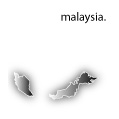 :: Here is a new Chinese label producing an amazing debut the delves heavily into the art of field recordings that is also a true tribute of some of the finest collective talent in today’s electronic music scene. As disc one opens with Seattle’s Climax Golden Twins’ “Relinquish” the air is spotted with high-wire tones and muted pastel drones. A big nod for the inclusion of the redolent reverb of Argentinian outsider quartet Reynols who always sound a bit like they are on the edge of singing the lounge favorite “Volare.” Miguel Tomasin’s elongated bellows on “Rasoyo Jisos Repuliom Alfazado” makes his voicebox more of a true instrument as the actual context of his words is twisted into the feedback of guitar and percussion. Toshimaru Nakamura’s “Preset #4 (nimb#28)” is part of an ongoing collection of tracks where the use of feedback is predominant. Here he uses the luxury of silent space as a breeding ground for new life from static. This is more of a Cy Twombly drawing than a Jackson Pollock, and when he adds a layer of swelling tonality it just flows lusciously through my head. Zai De’s high-pitched frequency on “Ni-Be” counters the bass scraping underpinnings of atonal percussion. This one actually hurts my eardrums. Another refreshing appearance comes from the anonymity of World Serpent’s Volcano the Bear and their circus-like trumpeting, hollow Philip Glassish strings and grumbly beasties on “Clayslaps.” This is pre-jazz, post-evolution; a sarcastic deja-vu of a muted Tiny Tim at the fair in some really dark film. Thuja’s “Untitled” track has the pedestrian percussion of an industrial kitchen, chop-chop, klang, bang with the subtle whir of a fan motor and a tribal simplicity. Carl Stone is back with the postmodern war-torn density of “Swad.” The bombs bursting in air are scattered in a screechy high-pitch mix that sounds like the intersection of east (illuminated dance ceremony) / west (a gunslinger’s desolation). “Copula” is Tham Kar Mun’s low-rise eternal morning buzz. He scrapes softly, and harsely – sounding like the documentary of a painter at work. Gongs cling, percussive paper shifts randomly, and crack a doodle doo. The piece is very live sounding with leanings toward bringing the textural qualities of his materials to life. The foghorn that leans in on Oren Ambarchi’s contribution “Freeze Out” is fat and bloated. Listen as this intro becomes a laser light of unconventional protection. Part one is completed by Sorbonne grad Eric la Casa’s “S’ombre Part 3.” His dedication to field recordings of nature’s bird calls; the contained brittle warp of branches or other organic matter offsets bees and a single water droplet.
:: Here is a new Chinese label producing an amazing debut the delves heavily into the art of field recordings that is also a true tribute of some of the finest collective talent in today’s electronic music scene. As disc one opens with Seattle’s Climax Golden Twins’ “Relinquish” the air is spotted with high-wire tones and muted pastel drones. A big nod for the inclusion of the redolent reverb of Argentinian outsider quartet Reynols who always sound a bit like they are on the edge of singing the lounge favorite “Volare.” Miguel Tomasin’s elongated bellows on “Rasoyo Jisos Repuliom Alfazado” makes his voicebox more of a true instrument as the actual context of his words is twisted into the feedback of guitar and percussion. Toshimaru Nakamura’s “Preset #4 (nimb#28)” is part of an ongoing collection of tracks where the use of feedback is predominant. Here he uses the luxury of silent space as a breeding ground for new life from static. This is more of a Cy Twombly drawing than a Jackson Pollock, and when he adds a layer of swelling tonality it just flows lusciously through my head. Zai De’s high-pitched frequency on “Ni-Be” counters the bass scraping underpinnings of atonal percussion. This one actually hurts my eardrums. Another refreshing appearance comes from the anonymity of World Serpent’s Volcano the Bear and their circus-like trumpeting, hollow Philip Glassish strings and grumbly beasties on “Clayslaps.” This is pre-jazz, post-evolution; a sarcastic deja-vu of a muted Tiny Tim at the fair in some really dark film. Thuja’s “Untitled” track has the pedestrian percussion of an industrial kitchen, chop-chop, klang, bang with the subtle whir of a fan motor and a tribal simplicity. Carl Stone is back with the postmodern war-torn density of “Swad.” The bombs bursting in air are scattered in a screechy high-pitch mix that sounds like the intersection of east (illuminated dance ceremony) / west (a gunslinger’s desolation). “Copula” is Tham Kar Mun’s low-rise eternal morning buzz. He scrapes softly, and harsely – sounding like the documentary of a painter at work. Gongs cling, percussive paper shifts randomly, and crack a doodle doo. The piece is very live sounding with leanings toward bringing the textural qualities of his materials to life. The foghorn that leans in on Oren Ambarchi’s contribution “Freeze Out” is fat and bloated. Listen as this intro becomes a laser light of unconventional protection. Part one is completed by Sorbonne grad Eric la Casa’s “S’ombre Part 3.” His dedication to field recordings of nature’s bird calls; the contained brittle warp of branches or other organic matter offsets bees and a single water droplet.
Arizonian Jeph Jerman kicks off disc two of Insight with a cacophony of birds and wildlife on “Grackles.” From an installation presented in the desert, this becomes a maze-like patchwork collage estuary. “Script Lichen” is Bay Area sound teacher Loren Chasse’s (23Five) inclusion. He has worked with Brandon LaBelle and Tuja among others. Wind, and the elements are at its center, creaky doors and light rain – making this an outdoor/indoor soundtrack. When the sky opens he captures the percussive tiny pellets hitting the ground as if minute glitch work is woven in, but this sounds like it may only be strictly open mic. La Casa (mics) returns with partners Dan Warburton (violin) and Jean-Luc Guionnet (sax) on a live recording performed in the Paris Metro. Warburton’s eerie strings instill a luring, sneering fear, while perfectly complemented by Guionnet’s elongated playing. The edge of the platform and passing trains roll on through along a constant buzz of something electric, like a broken neon sign, or the reverb made from a fluorescent bulb. “Bells 2” is a test in silence by Taku Sugimoto. The infrequent toll of a muffled bell keeps a patterned offbeat time signature, making this a perfect respite after some work that has been less than constant. In six minutes Tokyo’s guitar improviser Sugimoto (Bottrop-Boy, A Bruit Secret, etc) creates something of a dada haiku that falls in its own place, and acts like a chant. Yin Pin’s “Psalm 3:4” uses the edges of instruments to create a halo effect that is at once startling and distorted. The pitch is left channeled is top heavy, the boom-bang percussion is playfully desperate but brazenly serious. Heavy breathing is characterized with the calm of a dentist’s aerator on Berlin-based trumpeter Axel Dorner’s perforated “Marchlai.” This sounds like he is blowing hot glass, but he is circular breathing through is instrument without mixing or overdubs. It’s as if his lips and lungs were linked to a hot air balloon! And the way its edited sounds like a formatted tone scale that is a puzzle pulled apart and randomly pieced back into place, some lines connecting and some pleasantly not.
Janek Schaefer steps in with Maison A Bordeaux, something of a haywire molting guitar. The strings are warped and mistuned. Abundant in surrealistic possibilities, an atrophied Alfred Hitchcock through an hourglass comes to mind. Hamburg’s Andrea Neumann has a penchant for minor feedback and gentle electricity as she meanders inside a piano, with the utmost nuclear-scale glitch herein. Seattle’s Matt Shoemaker takes apart something of a forensic discussion that becomes a nonsensical radio play crossing MIT and some cheesy Frankenstein remake. The shear humor of “Pantai Ayu” reminds me of Hank & Slim and is quite startling, actually, especially when it adds some Western banjo theme. It all breaks up in thin air soon thereafter – a daydream? The watery perimeter of mnortham’s “epidermal filigree” could be the final hours of a long fishing day off the coast of Iceland. It could be many things – but by weaving a haunted drone that goes right through the centerpiece of this track, something extraterrestrial is undoubtedly formed, from thin air, from nothing really. The hopeless sequence in Mystic River when the bad guys have Tim Robbins pleading for his life comes to mind. In the end it is Lee Kwang whose “Stormy Weather” drains the sky one last time. His straight ahead recording of a fierce distant downpour captures the rapture and fury or the often feared, and misinterpreted weather system. Also included in this 25-track collection here are tracks by Yandsen, Tetuzi Akiyama, Yannick Dauby, Anthony Pateras & David Brown.
This recording is seemingly endless, and will curl the toes of anyone who places faith in those with the ability to brave the elements to mix it up.
::..:::…..:..::….:::::..:::..:::::::……:::…::.:::….::::..:..:::…::…….::::
Essential Links ::
::..:::…..:..::….:::::..:::..:::::::……:::…::.:::….::::..:..:::…::…….::::
Read more Microview’s ::
::..:::…..:..::….:::::..:::..:::::::……:::…::.:::….::::..:..:::…::…….::::
*Note :: Graphic for this country not available at time of publication.






